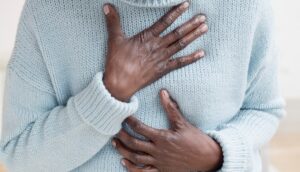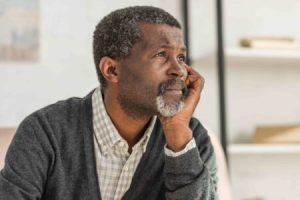A stroke is a medical emergency and requires treatment as soon as possible. To make that happen, you should know the symptoms and how to identify them quickly to prevent lasting brain damage or death. Unfortunately, Black people are at higher risk for stroke, so knowing the signs and risk factors is even more critical.
Types of Strokes
There are various types of strokes that you may experience. While experiencing symptoms, the first and most crucial step is to get medical care so that treatment can begin as soon as possible. However, the long-term treatment will vary depending on the stroke you’ve suffered.
- Transient Ischemic Attack (TIA): An ischemic stroke occurs when a blood clot develops in the brain or travels from elsewhere and blocks blood flow, damaging brain cells. These attacks present sudden symptoms similar to a stroke but typically don’t last as long. There is no way to tell whether the initial stroke symptoms are a hemorrhagic stroke or a less severe transient ischemic attack, so you should always assume that you need immediate medical attention and call for emergency care. A TIA is often called a mini-stroke and is the most common.
- Hemorrhagic Strokes: There are several types of hemorrhagic strokes. However, all of them include bleeding in the brain caused by a ruptured blood vessel. The hemorrhaging can quickly worsen, so early detection and treatment are essential. While not the most common type of stroke, it is the most dangerous.
- Silent Strokes: If a blood clot causes damage to an area of the brain that doesn’t cause any significant outward symptoms and is relatively minor, the stroke may go unnoticed. Some patients only find out they’ve had a silent stroke if they undergo a brain scan for an unrelated condition or if they experience a major stroke later, and evidence can be seen on a CT scan or MRI.
Signs of a Stroke
The symptoms of a stroke will vary from person to person. Even if the person has had a stroke before, another event could seem different based on severity and location. An ischemic stroke, a mini-stroke, will look different from a hemorrhagic stroke. You should never assume that every event will appear the same.
Some stroke symptoms aren’t outwardly visible, so you should always convey these to someone if you start to experience them. When someone is aware, they are better prepared to help you.
- Numbness: You may feel numbness in your face, arm, or leg, but usually only on one side of the body. Numbness of the face could cause drooping that is easy to identify.
- Weakness: This is usually accompanied by numbness, but not always. When there is no numbness, you may not notice the weakness until you try to do something like pick up a glass of water.
- Confusion: Trouble speaking coherently is one of the first signs of many strokes. However, it could be that you aren’t understanding the speech of others. If possible, try to communicate this.
- Vision Changes: These changes usually include blurry or double vision. However, it could also be narrowed or blackened. Any visual changes should be reported to someone nearby.
- Loss of Balance or Coordination: Others often easily observe trouble walking due to balance or lifting your legs. Try to remain seated to keep from injuring yourself.
- Severe Headache: A severe headache could cause vomiting, dizziness, and more as brain cells begin to die with a lack of blood flow.
What to Do If You Suspect a Stroke
What do you do if you are experiencing any of these signs or notice that someone else is? Follow the steps below to ensure you (or they) get the fastest care possible to avoid lasting brain damage or even death.
Act F.A.S.T
Use the acronym F.A.S.T. to check for the signs of a stroke. These symptoms may come and go over several hours or come on suddenly. You should assume that the event is ongoing and needs immediate medical attention.
- F(ace): Does one side of the face droop when smiling?
- A(rms): Does one arm slowly fall when raising the arms?
- S(peech): Is speech slurred? Does it sound strange? Is there trouble speaking a simple phrase?
- T(ime): Contact 9-1-1 or other emergency services for immediate medical attention if you notice any or all of the above symptoms.
Keep Track of Symptoms
Once you notice symptoms of a stroke, start taking notes. Keep track of what symptoms started, when, on what side of the body, and if the person has relayed any symptoms you haven’t observed. This information can be vital to an emergency care team as they work to identify the type of stroke and treat it appropriately.
Always Call for an Ambulance
It can be tempting to drive someone to the hospital yourself because you can get them to the hospital faster than an ambulance. However, the ambulance is equipped with trained EMS personnel and has life-saving medications that can be administered while on their way to the hospital. It is always best to call 9-1-1 in the event of a stroke.
Risk Factors for Strokes
Understanding the signs of a stroke is vital, especially if you know you or someone you love is at risk for one. Are you? There are many risk factors, from lifestyle choices you can control to age and gender, that you can’t.
Health Conditions
Having other health conditions can put you at a higher risk of experiencing a stroke. For example, suppose you have high blood pressure, atrial fibrillation, or another similar heart condition. In that case, it can affect the blood vessels in the brain and increase the chances of hemorrhagic stroke. Coronary heart disease, blood clotting disorders, and high cholesterol levels may increase your risk of developing a blood clot that can travel to the brain, where it could cause a transient ischemic attack.
Some other underlying health conditions that may make you more susceptible include diabetes, stress, kidney disease, migraine, and obesity. You should work closely with your primary care provider to manage these conditions.
Lifestyle Choices
You may have more control over stroke risk factors, such as smoking, diet, exercise, drinking alcohol, sleeping too much, and using illicit drugs. It can be difficult to eliminate or change these habits. However, there are many resources available to help. The CDC offers telephone and app support tools and access to medicines to quit smoking. Your primary care provider can help create a healthy diet and exercise plan or refer you to a dietician and physical therapist. The Substance Abuse and Mental Health Services Administration (SAMHSA) offers a 24/7 hotline with information and referrals for those with a substance use disorder.
Stress and Mental Health
Stress and anxiety contribute to stroke risk in several ways, including increasing blood pressure. Many people with poor mental health ignore their physical health, allowing it to decline as they develop diseases like diabetes from poor diet and exercise. If you are experiencing anxiety or depression, contact a mental health counselor or your primary care provider, who can refer you to one to help reduce your risk of stroke.
Age
According to the CDC, “the chance of having a stroke about doubles every ten years after age 55.” This is not to say that younger adults aren’t at risk as well. They also report that approximately one in seven strokes affects those under 49. While you may not be able to change the age risk factor, you can significantly reduce its impact by improving the ones you can control.
Gender
There is a significant disparity when comparing the number of Black adults affected by stroke compared to white people, especially when looking at gender. The US Department of Health and Human Services reports that in 2018, the number of African American men who suffered a stroke was relatively similar to that of white men. However, the number of African American women who experienced a stroke that year was double that of white women. The death rates were equally shocking, with both Black men and women more likely to die from a stroke than other races. In comparison, the risk of stroke is higher for a woman by 20-21% over the general population.
Family History
Studies show a definitive link between a family history of stroke and individual risk. This is on several levels, including the risk for stroke and the risk of developing health conditions that can lead to stroke, like high blood pressure and those that affect the arteries. Knowing your family’s medical history is essential so you can share this with your healthcare providers and work to minimize your risk.
Ethnic Background
The American Heart Association breaks down their long-term study following over 5,000 participants published in 2021. After 26 years, there were 100 strokes reported. While the rate of strokes between men and women was relatively similar, African Americans were four times more likely to suffer a stroke than white people of the same age. These results are startling and have given researchers new information on to base additional studies as they learn more about how heart health and stroke affect the Black population.
This is not the only study to prove such a correlation between racial identity and the risk of stroke or death. An AHA study in 2017 included participants from African countries, and another studied the recurrence of a transient ischemic attack in Black people who have already experienced one.
The Signs of a Stroke: When Every Minute Counts
Whether ischemic or hemorrhagic, all strokes are a medical emergency that needs immediate treatment to minimize long-term effects. Black people are disproportionately affected by stroke, so if you get a sudden and severe headache or any other signs of a stroke, communicate them to someone nearby as quickly as possible. Every minute counts when blood flow to the brain is compromised.
Black Health Matters understands that much of the Black population lives in areas with poor access to healthcare, which contributes to preventative treatment. By working with our partners and raising awareness of the gender and ethnic group disparities within the healthcare systems, we hope to improve the lives of African Americans in the US. Together, we can.








